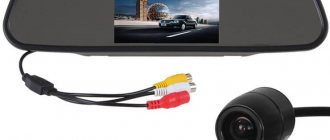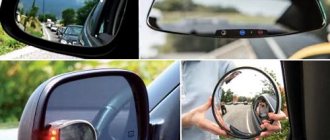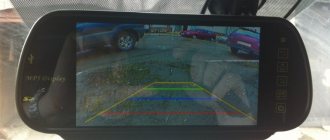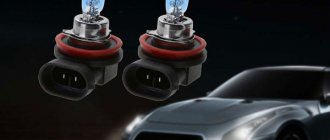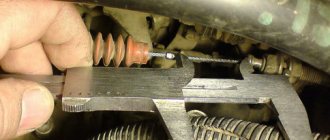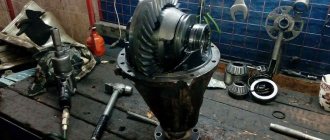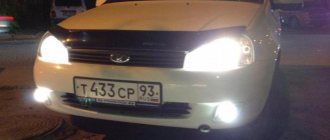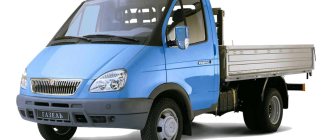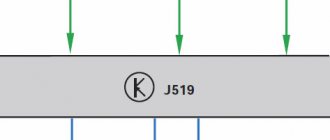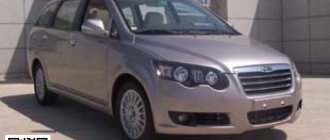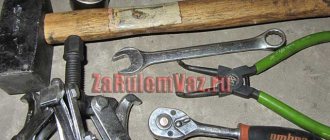In our online store you can buy a standard rear-view parking camera for a car of any popular brand. Consultants will help you choose the right model, and specialists will install the equipment quickly and professionally.
Parking based only on the mirrors is not easy in some cases: every car has a so-called blind spot. If a curb, a traffic pole, or, worse, a person gets into it, parking can end in disaster. Any reversing maneuvers require skill, and at dusk, in bad weather or in an unfamiliar place, even an experienced driver feels unsure.
The logical solution is to install a rear view camera; it will eliminate most parking problems and guarantee against unpleasant accidents. The camera starts working when the reverse gear is switched, processes the image and transmits the image to the monitor (standard head unit, TV, media center), if necessary, accompanied by additional markings.
How the rear view camera works
The camera itself is no different from a standard “webcam” or any other similar video surveillance device. Usually it is mounted on the rear of the car in the area where the license plate is located, and the image it captures is transmitted to the driver inside the car on an installed monitor. In this case, you can use either a separate monitor or a monitor integrated into the car (for example, an on-board computer). For convenience, the image is transmitted to the driver in a mirrored reflection; this effect is needed so that the driver does not get confused in the sides if he is on the safe side through the rear-view mirror. Parking sensor lines (something like a coordinate grid) can be superimposed on the resulting image, which will allow you to more accurately assess the situation behind the car.
Main advantages of the device
- Can work reliably in intensive mode;
- Have a long service life;
- Simple and easy to use;
- Most models comply with international standards;
- They have an aesthetic appearance.
In addition, in the Russian consumer market, rear-view cameras are technically complex devices and, before going on retail sale, undergo multi-stage quality control. Therefore, purchasing such devices at retail is safer than ordering them on various Internet sites. This even applies to Asian manufacturers - their products are also confirmed by Russian quality certificates.
Varieties
Any car enthusiast cares about the appearance of his car, so the installed camera should either be the least noticeable or fit harmoniously into the overall design of the car.
Devices are divided into the following types:
- Standard devices - they are supplied immediately with new cars and are attached by the manufacturer to a specially designated place in the car body (for example, in the place where the rear license plate illumination is installed, while the illumination itself will be implemented using the camera. Other standard places include the rear emblem of the car brand or the handle trunk opening). These standard gadgets are the least noticeable on the case - and this is understandable, because everything is pre-provided by the manufacturer. Their main drawback is their extremely narrow specialization and the inability to be modernized, because they are made for a specific make and model of car. Even if you try to install such a camera on another car, it simply may not be supported by the on-board computer of a car of another brand due to their incompatibility;
- Devices mounted in the license plate frame are the most versatile gadgets and can be easily installed on any make of car. The installation process is not complicated and can be done independently. However, such cameras have a significant drawback - they are extremely easy to dismantle, so they can become targets for thieves. In addition, if the car body in the area where the rear number plate is located has a specific factory bend (this mainly applies to Asian car brands), then some problems may arise with the installation.
There are also camera models whose versatility lies in their visual installation:
- Mortise devices - are installed in a special hole drilled in the rear bumper of the car and secured with latches/lock nuts. Drilling a special hole is the main disadvantage of installing such a camera, because if in the future it is no longer needed, the bumper will remain with traces of damage. But one of the advantages is that this device will be inconspicuous;
- Overhead devices - they are simply installed on brackets on the rear bumper (again, a drilling procedure will be required). It is even possible to secure them with double-sided tape, but in this case they can easily be lost over time when the adhesive base of the tape loses its performance properties.
Video Output Conditions
Devices for receiving video signals may differ in several ways. Depending on their combination, the driver can choose the most suitable scheme for himself.
Display devices:
- External screen - can be installed on the dashboard inside the car or installed on the rear view mirror, as if replacing part of the reflected image;
- Screen of an integrated car radio or navigator (appropriate resolution is required) or a standard DVR module.
Wired and wireless transmission:
- Cable connection - the video signal is first digitized by the camera processor, then converted into analog by the same processor and transmitted to the display device via wires laid inside the car. The main thing is that the display device supports either the American (NTSC) or European (PAL) color standard;
- Wireless connection - this option has an advantageous advantage, because it does not require laying a cable inside the car. However, it has limitations on the signal reception distance (no more than 15 meters) and such transmission may cause interference in the image.
Wireless connections can also differ in the type of signal modulation:
- Connection via FM waves - both the monitor and the camera have an external receiver and transmitter, respectively, through which their communication occurs;
- Wi-Fi connection – the camera creates its own password-protected access point, through which you can output to any external display device that supports Wi-Fi technology. The signal is transmitted in real time.
Image output options
As mentioned above, most cameras display images in a mirror format, so as not to confuse the driver regarding the image in the rearview mirror. However, professionals believe that it is better to choose an option where this function can be disabled. There is a situation here that can be compared to forcing left-handed people to write with their right hand - some people are better off perceiving images directly.
More about parking sensors
The rearview camera can overlay a virtual coordinate grid on the displayed image with information about the distance to the nearest object. However, for this function to work fully, it is necessary to calibrate the camera as accurately as possible when installing it. Typically, the parameters necessary for this (viewing angle, installation height) are indicated in the operating instructions. If these recommended specifications are not followed, the camera's grid will produce false information. It would also be nice if such functionality could be optionally disabled.
More about viewing angles
The greater the viewing angle of the camera model, the more it will be able to cover objects located behind the car. But it is always worth remembering that an extremely wide viewing angle will affect image distortion (the “fish-eye” effect). Also, if this angle is increased too much, the resulting image may appear “blurry”. Angles from 120 to 170 degrees are considered optimal. Below the minimum limit, cameras are considered narrow-beam, and above the upper limit, they are considered wide-beam.
Matrices used in cameras
Currently, rear-view cameras are practically no different from modern video equipment, and even in their designs you can find the use of professional elements (for example, lenses from). The following matrices are standardly used in modern samples:
- CCD – excellent image, excellent light sensitivity, but not the fastest processing speed of the output image at a fairly high cost;
- HCCD – the same as the previous one, but the resolution of the output image is increased;
- CMOS is the most common system and relatively inexpensive. It is characterized by high image processing speed, but light sensitivity is somewhat reduced. Although this drawback when the camera is operating at night can be easily compensated for by the rear lights. Moreover, the rear lights can be switched on automatically when the car starts moving in reverse.
Minimum required light
In order for the camera to work reliably in minimal lighting conditions, its photosensitivity must be in the range from 0.01 to 3 Lux. For a CCD matrix, an indicator of 0.01 Lux will be sufficient, but for CMOS higher parameters are already needed - 0.1 Lux.
Resolution used in rearview cameras
It is usually extremely small - only 628 by 582 pixels. Converted to standard values, this amounts to only 0.3 Megapixels. At first glance, it may seem that the resolution is extremely low, but more is not required. It’s unlikely that anyone will want to park on a 24-inch widescreen monitor that can support a resolution of 1900 x 1600.
Temperature for operation
Still, rear view cameras are extremely sensitive devices, so they are quite capricious to environmental conditions. More expensive models are equipped with special cases that maximally protect the working elements of the device from external influences by using special dust and moisture protection technologies. Standard devices are capable of operating in the temperature range from +25 to –65 degrees Celsius.
Special functionality
Devices can be equipped with additional functions:
- Infrared illumination – devices are supplemented with special LEDs that emit light in the invisible infrared range. This option allows you to better coordinate the work of parking sensors.
- Automatic exposure adjustment - depending on the current lighting, the transmitted image automatically becomes lighter/darker.
- Automatic white color correction – if there are heavy-duty lighting sources nearby (street lights, bright sun, etc.), the picture will darken.
- Remote control – found in sets of expensive video cameras and it provides the ability to enable/disable various options (“mirroring” the rear view, changing the viewing angle, etc.).
How to install a video camera?
The camera is mounted on the luggage compartment shelf of a car or on the luggage compartment lid. The signal from the device is supplied to the monitor via a four-wire cable. Two wires must be connected to the reverse lamp, and the rest must be pulled through the entire cabin to the monitor. The wires can be routed from below the body (this requires disassembling the plastic sills) or under the headliner. In the latter case, you need to remove the rubber seals and lay the cable.
Rating of the best rear view cameras for 2020
Mortise devices
3rd place: AUTOEXPERT VC-214 (393348)
This model is a classic budget option. It has relatively great functionality, but at the same time its price is much lower than flagship models with the same characteristics. Users report good picture quality when transmitting a signal in analog format. The ratio of image noise level and color rendering quality is quite satisfactory.
| Name | Index |
| Manufacturer country. | China |
| Resolution, pixels | 648x488 |
| Viewing angle, degrees | 170 |
| Operating temperature range in Celsius | +25 to -70 |
| Lighting, Lux | 0.6 |
| Supply voltage, V | 19 |
| Diameter, mm | 19 |
| Warranty, months | 12 |
| Price, rubles | 1700 |
AUTOEXPERT VC-214 (393348)
Advantages:
- Budget price;
- Multifunctionality;
- Excellent analog signal.
Flaws:
- Reduced light sensitivity.
2nd place: INCAR VDC-002 (408002)
In practice, it is able to provide excellent visibility thanks to a high-quality and large matrix based on CMOS technology. Visibility is maintained equally good both during the day and at night. Has increased image clarity.
| Name | Index |
| Manufacturer country. | China |
| Resolution, pixels | 628x582 |
| Viewing angle, degrees | 170 |
| Operating temperature range in Celsius | +25 to –60 |
| Lighting, Lux | 0.1 |
| Supply voltage, V | 18 |
| Warranty, months | 12 |
| Price, rubles | 2200 |
INCAR VDC-002 (408002)
Advantages:
- Large matrix;
- High image contrast;
- Enlarged sensor.
Flaws:
- There are no additional accessories included in the kit;
- There is a non-disabled “mirroring” mode.
1st place: AVIS 311CPR (433954)
This sample is truly a leader among inset cameras. It has a reinforced CCD matrix, maintains high photosensitivity, and requires a minimum of lighting for normal operation. The direct and mirror modes can be changed optionally at the user's request. It is possible to purchase many different accessories for this model (for example, a remote control).
| Name | Index |
| Manufacturer country. | China |
| Resolution, pixels | 512x492 |
| Viewing angle, degrees | 170 |
| Operating temperature range in Celsius | +25 to –55 |
| Lighting, Lux | 0.1 |
| Supply voltage, V | 18 |
| Warranty, months | 12 |
| Price, rubles | 4700 |
AVIS 311CPR (433954)
Advantages:
- Upgraded high resolution matrix;
- Availability of direct/mirror display function;
- Possibility of using additional accessories.
Flaws:
- Non-standard screw design.
Overlay cameras
3rd place: BLACKVIEW UC-27
This sample has the function of overlaying a coordinate grid on the image to simplify the parking process. Good light sensitivity allows you to perform complex reverse maneuvers even at night. Structurally, the working elements of the camera are perfectly protected by a dust- and moisture-proof housing.
| Name | Index |
| Manufacturer country. | China |
| Resolution, pixels | 628x582 |
| Viewing angle, degrees | 130 |
| Operating temperature range in Celsius | +25 to –65 |
| Lighting, Lux | 0.2 |
| Supply voltage, V | 12 |
| Warranty, months | 12 |
| Price, rubles | 1000 |
BLACKVIEW UC-27
Advantages:
- Very budget price;
- Has a parking sensor system;
- Dust- and moisture-proof housing.
Flaws:
- Narrow lens (120-130 degrees).
2nd place: XIAOMI 70 MAI HD REVERSE VIDEO CAMERA
This device is considered universal in terms of its recognition by standard on-board computers of various car brands. The image is transmitted in high resolution conditions. The case has a European degree of dust and moisture protection. The model is equipped with a highly sensitive sensor.
| Name | Index |
| Manufacturer country. | China |
| Resolution, pixels | 1280x720 |
| Viewing angle, degrees | 138 |
| Operating temperature range in Celsius | +25 to –70 |
| Lighting, Lux | 0.1 |
| Supply voltage, V | 12 |
| Warranty, months | 12 |
| Price, rubles | 1800 |
XIAOMI 70 MAI HD REVERSE VIDEO CAMERA
Advantages:
- A high resolution;
- Wide viewing angle;
- Versatility.
Flaws:
- Installing and connecting the camera to car systems is difficult for a non-professional to do on their own.
1st place: ALPINE HCE-C1100
This model is a flagship, as evidenced by its considerable price. High definition images can be transmitted in both digital and analogue formats. For such characteristics it has a rather low level of required photosensitivity - only 1.5 Lux. The kit includes a remote control. The camera can automatically adjust white balance and exposure.
| Name | Index |
| Manufacturer country. | Japan |
| Resolution, pixels | 1280x960 |
| Viewing angle, degrees | 180 |
| Operating temperature range in Celsius | +25 to –70 |
| Lighting, Lux | 1.5 |
| Supply voltage, V | 12 |
| Warranty, months | 12 |
| Price, rubles | 8000 |
ALPINE HCE-C1100
Advantages:
- Reinforced equipment;
- Compact body;
- Optional picture output mode.
Flaws:
- Not detected.
Frame cameras
3rd place: AUTOEXPERT VC-204
It can be installed in the license plate frame and can be freely adjusted vertically for better picture quality. The body of the device itself is resistant to various operational vibrations, the joining seams are perfectly adjusted, and the body is also resistant to direct exposure to ultraviolet rays. The 170 degree viewing angle simply leaves no blind spots.
| Name | Index |
| Manufacturer country. | China |
| Resolution, pixels | 648x488 |
| Viewing angle, degrees | 170 |
| Operating temperature range in Celsius | +25 to –70 |
| Lighting, Lux | 0.6 |
| Supply voltage, V | 15 |
| Warranty, months | 12 |
| Price, rubles | 2800 |
AUTOEXPERT VC-204
Advantages:
- Image clarity;
- Increased viewing angle;
- Availability of parking sensors;
- Can also be installed on the front license plate.
Flaws:
- Does not have a wireless interface;
- The image is transmitted only in mirror form.
2nd place: SHO-ME CA-6184LED
It has infrared LED illumination, which does not require the additional inclusion of rear parking lights. The coordinate grid of the parking sensors is superimposed on the transmitted image. Even without a wide-format lens, the camera confidently captures all interference at a distance of a meter from its location, which is quite enough to perform a safe maneuver. Requires a special installation height - at least 50 cm from the road surface (thus perfectly suitable for SUVs and crossovers).
| Name | Index |
| Manufacturer country. | China |
| Resolution, pixels | 545x420 |
| Viewing angle, degrees | 170 |
| Operating temperature range in Celsius | +25 to –60 |
| Lighting, Lux | 0.6 |
| Supply voltage, V | 12 |
| Warranty, months | 12 |
| Price, rubles | 2000 |
SHO-ME CA-6184LED
Advantages:
- Ease of installation;
- Availability of parking sensor grid;
- Confident recording of possible interference.
Flaws:
- Transmits only analog signal;
- More suitable for large cars.
1st place: AVS303CPR (CMOS)
This sample is the simplest in terms of integration - you just need to insert the number into the frame and attach it to the car; all other steps have already been completed at the factory during assembly. The camera supports color analog images and its video input is universal for almost any receiver. Equipping with infrared illumination does not require the additional use of rear marker lights. The housing is completely sealed, and the viewing angle can be adjusted horizontally.
| Name | Index |
| Manufacturer country. | China |
| Resolution, pixels | 648x488 |
| Viewing angle, degrees | 165 |
| Operating temperature range in Celsius | +25 to –30 |
| Lighting, Lux | 0.2 |
| Supply voltage, V | 12 |
| Warranty, months | 12 |
| Price, rubles | 2100 |
AVS303CPR (CMOS)
Advantages:
- Universal connection to receivers;
- Horizontal adjustment;
- The presence of infrared LEDs in the design.
Flaws:
- Afraid of low temperatures (down to -30).
Devices on external mounts (brackets)
3rd place: INCAR VDC-412
Despite its Chinese origin, this model is aimed at installation on cars of European brands, and premium ones at that. Installation of the device in the factory is very easy and does not take much time. The technical characteristics of the gadget will allow you to use it to the fullest. The infrared technology used in the device allows you to reverse with a sufficient degree of safety even when the rear lights are not working.
| Name | Index |
| Manufacturer country. | China |
| Resolution, pixels | 648x488 |
| Viewing angle, degrees | 170 |
| Operating temperature range in Celsius | +25 to –50 |
| Lighting, Lux | 0.5 |
| Supply voltage, V | 12 |
| Warranty, months | 12 |
| Price, rubles | 7500 |
INCAR VDC-412
Advantages:
- The housing is combined with a brake light;
- Availability of infrared illumination;
- Universality for European car brands.
Flaws:
- Low functionality at a relatively high price.
2nd place: AVS325CPR
A universal model, again aimed at European car manufacturers. Provides a good picture in zero light conditions thanks to its infrared illumination. The body itself is made of durable ABS plastic and can duplicate the brake light. Resistant to changes in ambient temperature and ultraviolet radiation. Users note the increased service life of the model.
| Name | Index |
| Manufacturer country. | China |
| Resolution, pixels | 762x504 |
| Viewing angle, degrees | 170 |
| Operating temperature range in Celsius | +30 to –70 |
| Lighting, Lux | 0 |
| Supply voltage, V | 12 |
| Warranty, months | 12 |
| Price, rubles | 8000 |
AVS325CPR
Advantages:
- Ability to work in zero light conditions;
- Increased resolution;
- Extended temperature range.
Flaws:
- Not detected
1st place: GARMIN BC 30
The most functional device in its segment. Capable of transmitting signals in both digital and analogue formats, has infrared illumination. Despite the average grip angle (140 degrees), it calmly copes with detecting potential obstacles when reversing. The case is equipped with today's best dust and moisture protection according to the European standard IP7.
| Name | Index |
| Manufacturer country. | USA |
| Resolution, pixels | 1280x960 |
| Viewing angle, degrees | 140 |
| Operating temperature range in Celsius | +30 to –50 |
| Lighting, Lux | 0.1 |
| Supply voltage, V | 12 |
| Warranty, months | 12 |
| Price, rubles | 16000 |
Garmin Accessories for Garmin nuvi and zumo navigators Garmin Wireless rear view camera BC 40 Black
Advantages:
- Wireless method of communication with the receiver;
- Variable mounting method using bracket;
- Increased resolution.
Flaws:
- High price.
Image output devices
The image from the rear view camera can be obtained in the following ways:
- Standard car monitor (7 inches or more). The device must have a multimedia interface to receive a video signal.
- New models of radio tape recorders with a display or on-site monitor (1 or 2 din). Such devices are usually equipped with a video input.
- Separate TV for the car. This solution is justified only for cars of older brands that do not have the above devices.
